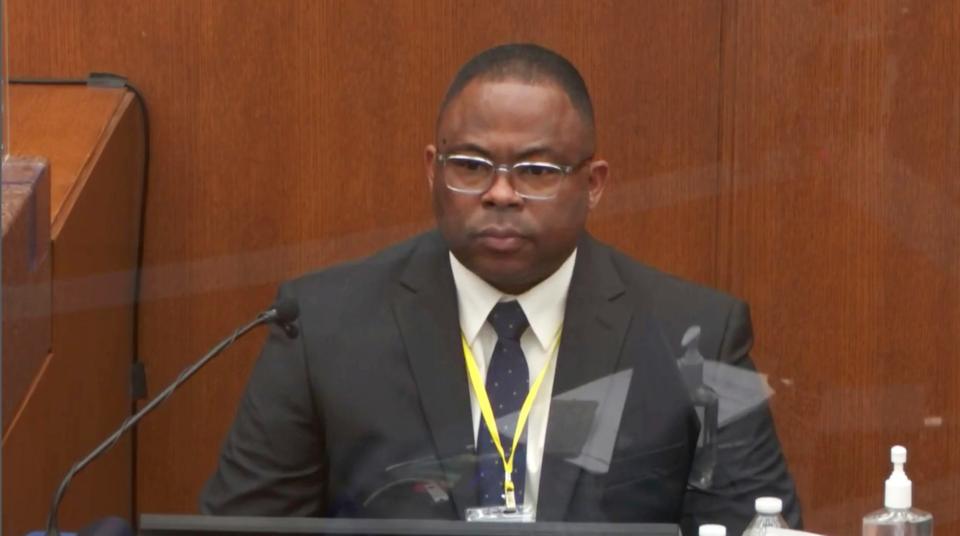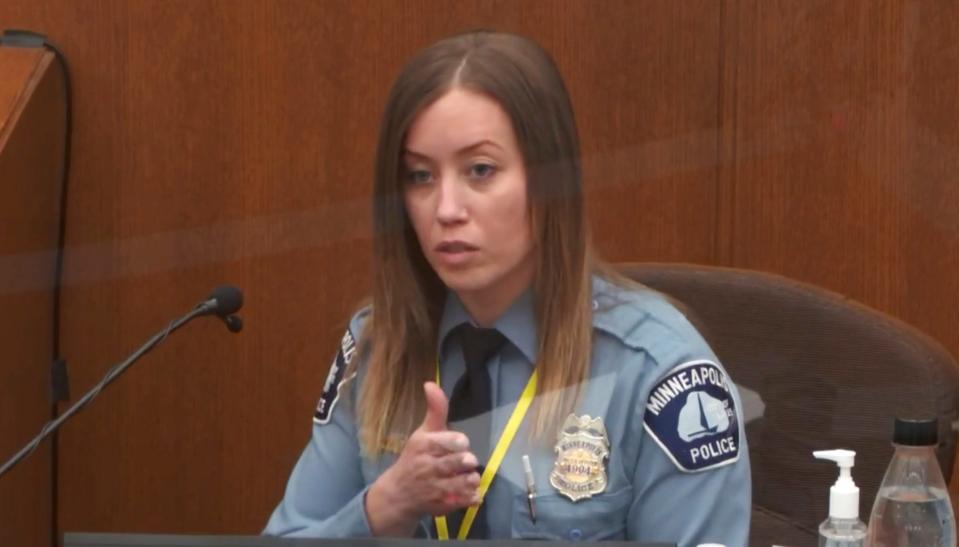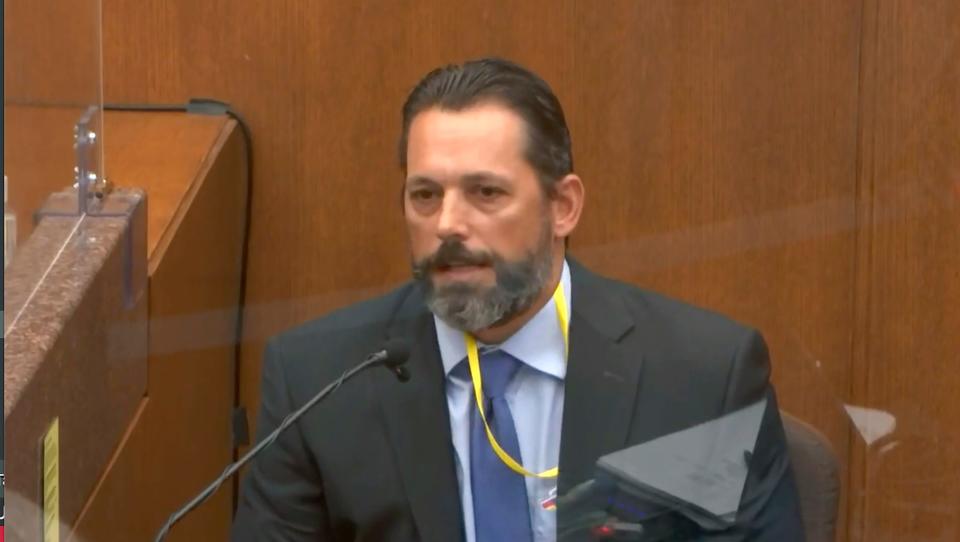Derek Chauvin trial, day 8: Expert says 'deadly' force was used on George Floyd
Follow Thursday's live coverage of the Derek Chauvin trial here.
MINNEAPOLIS — An expert witness told jurors in the murder trial of former Minneapolis police officer Derek Chauvin on Wednesday that Chauvin used "deadly" force on George Floyd and kept his knee on Floyd's neck for more than nine minutes.
Sgt. Jody Stiger, a Los Angeles Police Department officer who has conducted about 2,500 use-of-force reviews in his career, said the initial force used on Floyd was appropriate because Floyd was resisting arrest as officers tried to get him into their patrol car.
But after officers forced Floyd to the ground, "they should have de-escalated the situation," Stiger said. Instead, the officers continued to intensify the situation, he said.
Meanwhile, Rodney Floyd said Tuesday that his brother’s dying words from the videos played over and over again in the courtroom were supplanting his memory of their last conversation, in which they reminisced about their late mother. "When someone dies you cherish their last words, but my brother’s last words, oh, those words are stuck in my head. Agonizing," he told reporters.
Chauvin, who is white, is charged with second-degree murder, third-degree murder and second-degree manslaughter in the death of Floyd, a Black man who died in police custody on May 25, 2020.
Where the trial stands: Prosecutors have shifted from eyewitness testimony to focusing on Chauvin's use of force, trying to show Chauvin's restraint was excessive and led to Floyd's death. The defense has elicited testimony suggesting officers were threatened and distracted by an unruly crowd, faced initial resistance from Floyd and decided not to use a "hobble" restraint that would've tied his legs to his arms. The defense has argued Floyd died as a result of the drugs in his system and underlying medical issues.
Stay updated on the Derek Chauvin trial: Sign up for text messages of key updates, follow USA TODAY Network reporters on Twitter, or subscribe to the Daily Briefing newsletter.
Latest updates:
Court is in recess until 9:15 a.m. CST Thursday.
Two forensic chemists testified about finding the presence of methamphetamine and fentanyl in partial pills found in Floyd's Mercedes Benz and the back of a police squad car.
Special Agent James Reyerson of the Minnesota Bureau of Criminal Apprehension, the agency's lead investigator in the George Floyd case, also testified Wednesday.
Fourteen jurors – 12 to deliberate and two to serve as alternates – have heard from 30 witnesses called by the prosecution over the past week and a half.
The EMT who leads the Minneapolis Police Department's emergency medical response training said Tuesday officers are trained to call for an ambulance and provide medical aid if a situation is "critical." Officers who responded to Floyd did not render medical aid.
Minneapolis police Lt. Johnny Mercil, a use-of-force expert, was presented with an image Tuesday of Chauvin with his knee on Floyd's neck and told jurors the move was not a department-trained neck restraint.
McKenzie Anderson, forensic scientist who responded to crime scene testifies
McKenzie Anderson, of the Minnesota Bureau of Criminal Apprehension, took the stand Wednesday afternoon. Anderson works as a forensic scientist in the biology section at the BCA, doing DNA testing and body fluid identification as well as sample collection from physical evidence.
Anderson was called to the intersection of Chicago Avenue and E. 38th Street last May and responded with a technician and a photographer at about 1:15 a.m. on May 26, hours after Floyd was transferred to the county hospital and senior officers arrived on the scene. It had rained since the event, so Anderson collected no evidence from the scene.
The blue Mercedes, where Floyd sat in the driver seat, and the police squad car were towed to BCA's secured garage for further processing on May 27, at 9 a.m.
Two round white pills found in the Mercedes were packaged and sent to BCA's drug chemistry section for testing. A suboxone packet was found opened on the driver's side floor. Suboxone is a prescription medication taken by adults to treat opioid addiction.
Floyd's shoes, a black nylon strap and another white, rough-textured pill were found in the backseat of the squad car. The pill was not evaluated as evidence initially, but Anderson recovered it in January 2021 when the squad car was towed back from storage to BCA’s headquarters at the behest of defense attorneys.
Anderson processed the DNA off the saliva on that pill and it matched George Floyd's DNA profile.
Anderson collected four different blood stains on the seat bottom and an additional four stains on the rear passenger seat back. Anderson said all eight matched George Floyd's DNA profile.
Special Agent James Reyerson describes BCA investigation into Floyd's death
Special Agent James Reyerson of the Minnesota Bureau of Criminal Apprehension, the agency's lead investigator in the George Floyd case, took the witness stand Wednesday afternoon and recounted his memory of what happened May 25, 2020.
He told jurors he got a call from his supervisor that evening about "some form of critical incident" and went with other agents to a room at City Hall, where he learned Chauvin and three other officers were involved.
He arrived at the scene about 2:30 a.m. May 26. Reyerson, establishing chain of custody for Prosecutor Matthew Frank, said he seized the $20 bills from a manila envelope, plus a pipe, cigarettes and a card from inside the SUV. One of the bills was ripped in half.
Reyerson received a copy of Floyd's autopsy on June 4 and a toxicology report that showed Floyd was under the influence of some substance.
The cars were towed away and then processed May 27. The defense examined the squad car of Officers Lane and Keung, finding a pill in the backseat. The pill was given to BCA headquarters to be processed in the crime scene garage.
Reyerson acknowledged to defense attorney Eric Nelson that they did not notice the pill in the car at first. He had reviewed 750 photos in the investigation, and he didn't notice it at first.
The prosecution asked for the re-processing of Floyd's Mercedes SUV in December.
Frank's questioning also addressed the weight disparity between Floyd, who weighed more than 200 pounds, and Chauvin, who weighed 140 pounds. Frank asked Reyerson about the additional weight Chauvin had on his belt. Reyerson testified that the equipment Chauvin wore during the struggle added 30 to 40 pounds.
On cross examination, Nelson asked questions that showed the scope of the BCA investigation which involved initially about 50 agents, dozens of search warrants, some 200 citizen witness interviews and 440 reports. Nelson noted that the protests in the aftermath of Floyd's death played a role in the investigation.
"This investigation has been ongoing since essentially May 25, 2020," Nelson said, adding that it is ongoing. Reyerson agreed.
After listening to a short clip of Floyd's arrest recorded on a body-worn camera, Reyerson agreed with Nelson that it sounded like Floyd said "I ate too many drugs."
Frank, on re-direct, took aim at the "I ate too many drugs" allegation by Nelson, getting Reyerson to acknowledge that he didn't hear the question before and that it was difficult to make out.
After listening to a longer version of the video Reyerson said he heard Floyd say "I ain't do no drugs."
Expert witness Sgt. Jody Stiger says Chauvin used 'deadly' force
Sgt. Jody Stiger of the Los Angeles Police Department returned to the witness stand Wednesday morning. Stiger estimated he has provided training to about 6,000 officers in de-escalation, basic patrol tactics and other subjects
Stiger told jurors Tuesday that, after reviewing the case, he determined Chauvin's use of force was "excessive."
On the severity of Floyd's crime, Stiger said that, given the alleged offense – trying to pass a counterfeit $20 bill – "you wouldn't even expect to use any kind of force." On assessing whether Floyd was a threat to the safety of others, he said the size and stature of a subject may be relevant but that it is not appropriate to use force against someone simply because of their larger size.
On Wednesday, Stiger testified that, based on time stamps from police body cameras, the pressure Chauvin exerted on Floyd lasted nine minutes and 29 seconds and that Chauvin maintained knee pressure on Floyd's neck throughout that entire period.
Stiger said the number of officers on the scene outweighed any threat posed by Floyd, who was not actively resisting while he was in the prone position. He said "no force should have been used after he was in that position." But the pressure continually exerted by Chauvin "raised the possibility of death," he said.

"You can hear Mr. Floyd displaying his discomfort and pain, and you can hear the defendant responding to him," Stiger said. He added that Chauvin had 866 hours of paid training during his 19 years on the force, which should have been sufficient for him to deal with a distraction of the crowd.
During early cross examination by lead defense attorney Eric Nelson, Stiger acknowledged he never previously testified in any court as an expert on police use of force.
Using references to Minneapolis police radio transmissions, Nelson got Stiger to agree that Chauvin had reason to believe while en route to the scene that Floyd was 6 to 6 1/2 feet tall and apparently impaired by drugs or alcohol.
Nelson concluded the line of questioning by showing side-by side views of two videos – one, bystander video, the other, from a police body camera. Stiger agreed that the bystander video showed Chauvin's knee was on Floyd's neck. Stiger also agreed that the body camera video showed that the knee was more "at the base of the neck," in between the shoulder blades.
EMT Nicole Mackenzie: Officers must call ambulance, render aid if situation is 'critical'
Minneapolis Police Department officer Nicole Mackenzie, an EMT and the department's medical support coordinator, told jurors that officers are required to administer medical aid and call for an ambulance if a situation is "critical."
Mackenzie said officers receive CPR training every other year. Prosecutor Steve Schleicher posted CPR cards issued to Chauvin to show he had the necessary training.
Mackenzie said department policy instructs officers to check for a pulse and give and continue CPR until someone more senior is on the scene with advanced training, there are obvious signs of death or until the officer is completely exhausted.

Asked by prosecutor Steve Schleicher about whether someone who is speaking is always able to breathe, Mackenzie said: "Just because they're speaking doesn't mean they're breathing adequately."
In cross examination by defense attorney Eric Nelson, MacKenzie acknowledged some situations may prevent an officer from calling EMS. Her testimony was cut short as the defense said they planned to call her back, as early as next Tuesday, for their case.
Sgt. Johnny Mercil, use-of-force instructor: Officers weren't taught to put their knee on neck
Minneapolis police Lt. Johnny Mercil, who heads the training division’s use of force lessons and taught a class attended by Derek Chauvin in October 2018, told jurors Tuesday that a still-image of Chauvin kneeling on Floyd’s neck is not a restraint taught to Minneapolis Police Department officers.
Mercil said using a knee on the neck or back can be an authorized use of force, but it's usually transitory and depends on the time frame and type of resistance. If the subject is handcuffed and not resisting, it is not authorized, Mercil said.

"There’s the possibility and risk that some people have trouble breathing when they’re handcuffed (to their back) and on their stomach," Mercil said. A person is rolled on their side to prevent positional asphyxia, Mercil said. The officer should turn the person to this position "sooner the better," though he noted it depends on the situation and environment.
Under questioning by Chauvin's attorney, Eric Nelson, Mercil acknowledged use of force techniques do not have a strict application in every instance and that officers are taught to be fluid and react to the circumstances they face. Mercil also agreed under questioning that some people make excuses to avoid arrest, and that he has had suspects say "I can't breathe" when he was trying to arrest them. Read more.
This article originally appeared on USA TODAY: Derek Chauvin trial day 8: George Floyd force 'excessive,' expert says

 money
money 